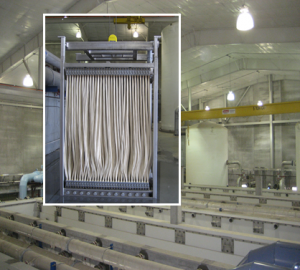 Membrane technology is effective at helping municipalities meet new regulations, improve water quality, and reduce both operations and maintenance costs. Through a variety of application techniques, membrane treatment can be used to meet varying water quality requirements; it can also produce entirely different results. Here’s a closer look at two recent membrane installations that used two very different applications in two different regions of the country with two different types of membranes.
Membrane technology is effective at helping municipalities meet new regulations, improve water quality, and reduce both operations and maintenance costs. Through a variety of application techniques, membrane treatment can be used to meet varying water quality requirements; it can also produce entirely different results. Here’s a closer look at two recent membrane installations that used two very different applications in two different regions of the country with two different types of membranes.
The City of Bossier City, La., was experiencing significant population growth resulting in increasing water demand. The existing water treatment plant serving the community was aging but still useful. To supplement the existing plant, the city opted to build a new 25 million gallons per day (MGD) water treatment plant that included pressurized membrane treatment. The resulting plant delivers high-quality drinking water and positioned the city to provide adequate water to the community for many years to come.
 The City of Wichita, Kan., wanted to use the Little Arkansas River to serve its community’s water needs but had to have a solution that would allow it to remove excess surface water and treat it to drinking water standards. The solution was to construct a 30 MGD facility that met those objectives and also recharged water into the local Equus Beds aquifer. The treatment process involved sedimentation, strainers, submerged ultrafiltration membranes and an advanced oxidation process (AOP).
The City of Wichita, Kan., wanted to use the Little Arkansas River to serve its community’s water needs but had to have a solution that would allow it to remove excess surface water and treat it to drinking water standards. The solution was to construct a 30 MGD facility that met those objectives and also recharged water into the local Equus Beds aquifer. The treatment process involved sedimentation, strainers, submerged ultrafiltration membranes and an advanced oxidation process (AOP).
While these two systems have similar treatment processes, there are subtle differences that present challenges to the design, construction and startup. These differences can cause significant problems if not carefully considered during all phases of the project.
Interested in this kind of technology? I’m headed to Vegas on Wednesday, March 12, for the 2014 Membrane Technology Conference. I’ll be presenting detailed case studies in a presentation called “A Tale of Two Membranes.” I’ll share our lessons learned from the design, construction and startup of both systems and will also review the similarities and differences and explore some of the different strategies and tactics our team used during the course of the execution of these projects.
If the Membrane Technology Conference is on your agenda, I hope you’ll come by the water technology session. And if you’d like to connect in advance of the conference, feel free to reach out to me on LinkedIn – my contact information is below.
Jake White, PE, is a senior environmental engineer in Burns & McDonnell’s Water Group. He is responsible for executing complex assignments associated with the design of potable water treatment, distribution systems, wastewater treatment and collection systems.
